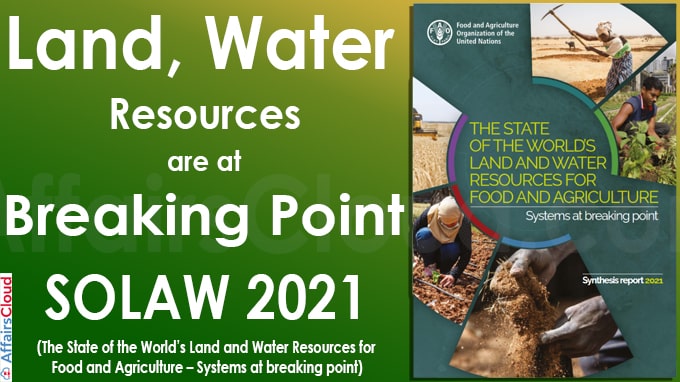 The Food and Agriculture Organization of the United Nations (FAO) launched the State of the World’s Land and Water Resources for Food and Agriculture – Systems at breaking point Synthesis report 2021 (SOLAW 2021), which highlights the worsening state of the earth’s soil, land and water resources and the challenges it poses for feeding a global population which is expected to reach 10 billion by 2050.
The Food and Agriculture Organization of the United Nations (FAO) launched the State of the World’s Land and Water Resources for Food and Agriculture – Systems at breaking point Synthesis report 2021 (SOLAW 2021), which highlights the worsening state of the earth’s soil, land and water resources and the challenges it poses for feeding a global population which is expected to reach 10 billion by 2050.
- The central theme of SOLAW 2021 is “Systems at breaking point”.
- SOLAW 2021 is a collaborative effort led by the Land and Water Division of FAO in collaboration with several divisions/units at FAO
Note:
The SOLAW 2021 Synthesis Report presents the main findings and recommendations of the full SOLAW 2021 report and background studies, which will be published in early 2022.
Key Messages of SOLAW 2021
The State:
- The interconnected systems of land, soil and water are stretched to the limit.
- Current patterns of agricultural intensification are not proving sustainable
- Farming systems are becoming polarized.
The challenges:
- Future agricultural production will depend upon managing the risks to land and water. Land, soil and water management needs to find better synergy to keep systems in play
- Land and water resources will need safeguarding.
Responses and actions:
- Land and water governance has to be more inclusive and adaptive.
- Integrated solutions need to be planned at all levels if they are to be taken to scale.
- Technical and managerial innovation can be targeted to address priorities and accelerate transformation.
- Agricultural support and investment can be redirected towards social and environmental gains derived from land and water management.
Gist of the report:
i.The Synthesis report 2021 states that Grassland and shrub-covered areas used to graze animals or as sources of fodder have declined by 191 million hectares in the past 20 years, to 3196 million ha in 2019 and converted to cropland. Cropland increased by 63 million hectares between 2000 and 2019.
ii.With the increase in population, the agricultural land available per capita for crops and animal husbandry declined by 20 per cent between 2000 and 2017 to 0.19 ha /capita in 2017.
iii.The overall change in the per capita distribution of freshwater resources is consistent with an increase in population. Between 2000 and 2018, the decline in global per capita internal renewable water resources (IRWR) was about 20%. Europe (3%) has the lowest percentage change.
iv.The change was greater in countries with the lowest per capita IRWR, like sub-Saharan Africa (41%); Central Asia (30%); Western Asia (29%) and Northern Africa (26%).Click here for the complete report
Recent Related News:
The Food and Agriculture Organization of the United Nations (FAO)’s The State of Food and Agriculture (SOFA) 2021 Report entitled “Making agrifood systems more resilient to shocks and stresses” states the need to enhance the resilience of the agri-food systems to address food security.
- The report provides an assessment of the ability of national agrifood systems to respond to or recover readily from shocks and stresses.
About Food and Agriculture Organization of the United Nations (FAO):
FAO is a specialized agency of the United Nations(UN) that leads international efforts to defeat hunger.
Director-General– QU Dongyu
Headquarters– Rome, Italy




